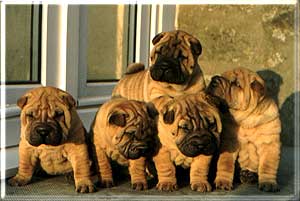 |
 |
|||||
|
Prime Objective for Breeding…
|
||||||
|
Kavishi Pup-peis |
||||||
|
Breeding
dogs is not fast or easy money, people come in and out of the Sharpei breeding
arena regularly, the ones who are around long term have a huge love of
their breed and the driving force for them is often to create the most
perfect puppy they possibly can, for the Show ring, they want to
contribute to the improvement of the breed, to help stamp out any health
problems in the breed, they want to participate in the ongoing development
of the breed, the improvement of the breed is the prize of
breeding a sharpei that conforms perfectly to the breed standard…
To honestly know if your Sharpei will help improve
the breed, you must first be very familiar with the breed standard. If you
aren't familiar with the breed standard, how will you know what you are
striving for? Quality
One of the first misconceptions that most people have, is that if a dog is registered it is of high quality. We wish this was the case, however, … this simply is not true. Registration only shows that the dog's sire and dam were registered. Registration is a prerequisite to breeding or showing a dog, but should not be a deciding factor concerning quality… Another thing to consider should be the type of contract under which you purchased the dog. If the breeder you bought the dog from sold it to you as a pet (on a spay/neuter contract), you should honour that contract. Also the breeder will be heavily involved in Showing their Pei's, as a breeder is striving for the perfect specimen to show in the ring, why else would anyone breed, if not for betterment of the breed. An experienced Breeder will have spent many years evaluating dogs, and if they have already made a predetermination about the dog's quality, you should be willing to accept that evaluation, the case may be that a puppy after development has grown into a beautiful specimen, however the breeder may contractually prohibit breeding to protect their bloodline from indiscriminate breeding by owners who are un-knowledgeable and in one fell stroke can ruin the reputation of a bloodline by producing a litter of unhealthy puppies... If you bought your dog as a show/breeding
prospect, you still must make an honest evaluation of your dog as an
adult. A beautiful puppy can develop badly, the runt of the litter may
grow into a beautiful creature and become a champion… Many owners think that their dog should have at least one litter, for their temperament or some other obscure myth….not true…. all dogs should not reproduce, no matter how much you love them or how many titles they may have. Knowing the breed standard is more than
memorising it, you must understand and visualise what it means. This takes
time and experience…There are no short cuts….Do your homework, research
the breed, look at many different dogs; at shows, at various kennels, etc.
Find breeders who are willing to be honest about their own dog's strengths
and weakness – you should learn a lot. Remember at shows to watch the
dogs, and not the judge's choice, since their choice may or may not be the
soundest dog at the show. The next step is to study your dog's pedigree.
Most don't have the privilege of personally knowing all the dogs in
a pedigree, but ask people who do know, search for old photographs, and
study the other offspring of the dogs listed there. Find out as much as
possible about your dogs parents, grandparents etc longevity is important
and is often a key health indicator for future generations. Championships
titles in a pedigree have value, though their value is limited. Gaining a
championship is not necessarily proof that a dog is of good quality (some
champions simply don't deserve the honour), If there are no titles there,
it may be an indication of a general lack of quality. On the other hand, a
pedigree may be a veritable "Who's Who" of the show world, and still your
dog may not be of the quality to breed. Search, search, search, and find
out all that you can…we did say that it wasn’t easy ... Consider the number of unwanted
dogs in Rescue centres throughout the country, so ensure that you will be
able to find caring, responsible and permanent homes for the resulting
litter... |
||||||
|
||||||
|
Now …all that is just a starting point. If you
can't or won't meet any one of these criteria, perhaps breeding is not the
best thing for you, your family or your dog… Most important…Most breeders, even the successful ones do not make a lot of money from breeding dogs, so…. Don’t Breed for Greed!! and Please don’t litter up the country with unwanted, uncared for pup-pei’s… |
||||||
| Decided to continue..then read on!! | ||||||
|
Why do I have to learn all the stuff about genetics just to breed a dog? Dog breeders engage in
‘genetic experiments’ each time they plan a mating. The type of mating
selected should coincide with set objectives. For some breeders,
determining which traits will appear in the offspring of a mating is a
combination of luck and chance. For others, producing certain traits
involves more skill than luck… the result of careful study and planning.
When evaluating your
breeding program, remember that most of the traits you're looking for,
cannot be changed, fixed or created in a single generation. The more
information you can obtain on how certain traits have been transmitted by
your dog's ancestors, the better you can prioritise your breeding
objectives… What the heck is Phenotype and Genotype?It
is also important to understand that there is a major difference between
the appearance of an animal (called its phenotype) and its genetic makeup
(called its genotype). Most commonly encountered discussions of canine
size, weight, coat colours, are basically phenotypic, as in most cases we
can only describe the appearance of the dog in front of us…
|
||||||
| cutftp32.exe |
Site Researched and Produced by ©Kavishi Shar-Pei |
|||||